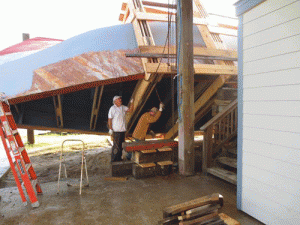Ten of the best years of my life concluded just before Thanksgiving Day when the 52’ wooden boat called Endeavor rolled a hull 180 degrees to an upright position. Now, it looks like a boat, but in December of 2004 it was more of a dream. A nine foot tall stern was cut using several pieces of marine plywood; screwed and glued to form the first complete component of Endeavor. The craft has since come a long way. The building site was changed, the hull was lengthened, and the design was set to that of a World War II PT boat.
The keel was laid and the stem attached to a transom of solid mahogany. Fourteen frames were added between the stem and transom, strengthened by longitudinal stringers from bow to stern. This took six years. At this time, the boat weighed 8,055 lbs., was right side up (with the keel down) and needed to be rolled so that the hull could be constructed.
Don Haynes of Action Welding came to the rescue with a 15 ton crane and several men. In a few hours the boat was rolled and a new phase of hull construction began. This consisted of adding longitudinal stringers to the bottom (could not be done as the boat was resting on the bottom) and by adding four thicknesses of 3/8” marine mahogany plywood. As I added the plywood, I figured the weight. It became clear that when the hull was to roll again, it would weigh 17,000 lbs.
The 3/8” marine mahogany plywood comes in 4’x8’ sheets. Ripping the sheets into 8” wide strips (or planks) provides six planks per sheet. Strips are necessary to insure taking the boat’s contours properly, without fracturing or resisting the accuracy of the bend. Total plywood is 140 sheets, or 840 planks. At 45 pounds per sheet, the weight adds up, and this does not include the hardware or epoxy. And the hull is still not ready for painting.
The final protective measure is fiber glass. It does not weigh as much, but needs to be filled with epoxy and left to set four days before final sanding and painting. Once the epoxy sets up, four coats of marine, epoxy paint is added and two coats of red anti-fouling bottom paint on top of that.
All along, I knew the boat would need external protection to roll. Otherwise, it would destroy itself. On rainy days I worked underneath, adding athwart ship stringers to support the post and starboard shears, but this would not be enough. Five square wheels were built externally, around the entire boat. This would enable the boat to roll 90 degrees at a time, but would add even more weight.
Friends keep in touch, and Don Haynes of Action Welding drove by almost daily. One day he asked me how much the boat weighed. I answered very close to 20,000 pounds. He wondered how he could be of help.
The task of rolling the boat weighed heavily.
But, where there is a will, there is a way.
Boating people are a close knit bunch, and several friends of mine transport sailing vessels from Europe, or wherever, to wherever. One such friend is Fritz Ficke of Tuscon, AZ and glad to say that I have known him and his wife Leah for more than twenty years. They follow my progress faithfully and were eager to know how I plan to roll the boat. I mentioned Don Haynes and also the prospect of bringing in a crane from Victoria. However, as I learned on the first boat rolling, a crane only lifts the boat. It cannot do the rolling.
Fritz and Leah told me to give them two weeks’ notice and they would come to Port O’Connor.
Don Haynes stayed in touch, so when Fritz and Leah arrived, Don was right here. Fritz had ideas on rigging the roll, and Don Haynes gave us the use of chains, hydraulic jacks, and chain come-a-longs, but he could not get the crane close enough to ensure a safe lift.
It did not take long to realize that Fritz knew what he was doing. We attached chain come-a-longs forward, mid ships, and aft, to the pylons that run the length and on each side of the boat. Two more chain come-a-longs were hung over the top of two pylons for lifting and dragging the high end, but to get the boat started, two hydraulic bottle jacks fore and aft were needed. The boat lifted a half inch at a time.
Soon a rhythm was established; pull the come-a-longs fore to aft, one at a time and jacking simultaneously. It took three days from dawn to dusk. As the boat rose, blocking was placed underneath for safety. Rain on one day did not stop the work, and the next day we worked in mud. Working the equipment against the square wheels and never placing a come-a-long or jack against the boat, the work finally came to fruition. On the final 90 degrees of roll, the boat settled on the pylons and slid to rest. The transom was level as was the keel. The pylons will never be the same.
All the meals were furnished at Josie’s Restaurant and drinks, too.
Fritz refused any offer of money, even gas money from Tuscon – a distance of 1,100 miles. They say a friend is worth a million dollars, and that thanks is never required.
“No one has ever rolled this boat before. In fact, few people have ever rolled any boat,” Fritz said as they started the drive home.
*Editor’s Note: Larry Wegeman has been reporting on his progress in Dolphin Talk since November of 2010. When it is completed and launched, he plans to live aboard his boat.




